Satas D., Tracton A.A. (ed.). Coatings Technology Handbook
Подождите немного. Документ загружается.


432
HUBER
AND
STOYE
4.
J.
Darffel,
J.
Ruter, W. Holtrup, and R. Feinauer,
Furbe
und
Lmk,
82, 796 (1976).
S.
J.
Darffcl and
U.
Biethan,
Farhe
urd
kick,
82, 1017 (1976).
6.
W. L. Hcnsley,
Paint
Vorn.
Prod..
p.
68 (1966).
7.
R. Gras and H. Riemer,
U.S.
Patent
4,528,355 (1985);
Huls.
8.
R. Capanni et al.,
Furh
Lack,
78, 831 (1972).
9.
V.
Mirgel and K. Nachtkamp,
Forhe
Lack,
89, 928 (1983).
10.
K. Schmitt,
J.
Disteldorf, and F. Schmitt,
U.S.
Patent
4,151,152 (1975);
Huls.
1
I.
D. Berger,
U.S.
Patents
4,097,465 4,097,466 (1975);
Huls.
12.
K.
H. Homung and
U.
Biethan,
Farbe
Lack.
76, 461 (1970).
13.
U.
Biethan, K. H. Homung, and G. Peitscher,
Cl~em.
Ztg..
96, 208 (1972).
14.
U.
Biethan and
K.
H. Homung, in
Tenth FATIPEC
Congress Book,
1970,
p.
277.
15.
U.
Biethan,
J.
Darffel, and D. Stoye,
Farlle
Lack,
77, 988 (1971).
16.
A. Schott, R. Gras, and
E.
Wolf,
U.S.
Patent
4,258,186 (1977);
Huls.
17.
F.
0.
Stark, in
Organic
Coatings,
Science
and Technology,
Vol.
6.
New York: Dekker,
1984,
18.
D. L. Edwards et
al.,
Point
Varn.
Prod., p.
44
(
1966).
19.
M.
F.
Koistra,
J.
Oil
Colour.
Chern.
Assoc.,
62, 432 (1979).
20.
U.
Biethan et al.,
Ulln7orzr1.s EncyclopNrlie
Tec/rni.sche
Chemie.,
Vol.
15.
Weinheim: Verlag
21.
K. Bruning and K. G. Sturm,
U.S.
Patent
4,054,681 (1977);
Dynarnit Nobel.
22.
H.
J.
Holscher,
New
Verpack.,
l,
46 (1984).
23.
D>VIU~[J/ Copolyesters for
Cocrtings
trnd
Adlzesives
(product information leaflet), Huls AG,
24.
DV~lpd
Coutirzgs
(product information ringbook), HUls AG, Marl, West Germany.
25.
Vesturit-Suturoted Polyester
Resins
for
Stovirzg
Encunel.s
(brochure),
Huls
AG, Marl, West
26.
Technical Service Report GTSR
22
and GTSR
36,
Amoco Chemicals Co., Naperville,
11.
27.
G. Schade,
U.S.
Patent
4,104,262 (1978);
Dynamit Nobel.
28.
J.
Darffel,
Furhe
Luck,
81,
IO
(1975).
29.
J.
Dnrffel and W. Auf der Heide,
Furbe
krck,
86, 109 (1980).
30.
D. W. Sartorelli and R. R. Smith, EP Patent
0105016 (1983);
Goodyear.
31.
W. H. Carothers,
Truns.
Faraday
Soc.,
32, 39 (1936).
32.
P.
J.
Flory,
J.
Am.
Cllenz.
Soc.,
63, 3083 (1941).
33.
P.
J.
Flory,
Principles
of
Polynzer
Chemistry.
Ithaca, NY: Cornell University Press,
1953,
pp.
34.
T. G. Fox and P.
J.
Flory,
J.
Appl. Phys..
21, 58
1
(1950).
35.
T.
G.
Fox,
Bull. Am.
Phys.
Soc.,
I,
123 (1956).
36.
D. W. van Krevelen,
Properties
of
Polymers.
New York: Elsevier,
1972.
37.
W. A. Lee and R. A. Rutherford,
Polvmer
Handbook,
Vol.
111.
Ncw York: Wiley
(1975),
p.
38.
R. Hill,
Fihres,frorn
Synthetic Polymers.
London: Elsevier,
1953.
39.
L. Buxbaum,
At7gew. Chn.,
80,
225 (1968).
40.
W. Andrejewski and D. Stoye, British Patent.
1
481 182 (1973);
Huh.
41.
W.
J.
Mijs, W.
J.
Muizebelt, and
J.
B. Reesink,
J.
Coutings
Techtzol.,
55,
45 (1983).
42.
D. Stoye, W. Andrejcwski, and
J.
Dorffel,
Thirteenth
FATIPEC
Congresshook,
1976,
p.
605.
43.
D. Stoye and
J.
Dtlrffel,
Ad\?.
Org.
coating.^
Sci.
Td~nol.,
2, 183
(1980).
44.
D. Stoye and
J.
Dorffel,
Pigment
Resin Techno/.,
4; 9(8). 8 (1980).
45.
L. Gott,
J.
Cotrtirzgs
Techno/.,
48, 52 (1976).
46.
R. Buter,
Fnrbe
Lrrck,
86, 307 (1980).
47.
D. Stoye and
J.
Darffel, in
Orgunic
Coafings,
Science
urd
Teclzrzology,
Vol.
6.
New York:
48.
L. W. Hill and
K.
Kozlowski,
J.
Cncrrirlgs
Techno/.,
59, 63 (1987).
pp.
87-100.
Chemie,
1978,
pp.
625-628.
Marl, West Germany.
Germany.
568-576.
139.
Dekker,
1984,
pp.
257-275.

POLYESTERS
433
49.
50.
51.
52.
53.
54.
55.
56.
57.
58.
59.
60.
61.
62.
63.
64.
65.
66.
67.
68.
69.
F. N. Jones and D. D.-L. Lu,
J.
Coatings
Techol.,
59, 73 (1987).
K.
H. Albers, A. W. McCollum, and A. E. Blood,
J.
Paint
Techrlol.,
47, 71 (1975).
M. R. Olson,
J.
M. Larson, and
F.
N. Jones,
J.
Cocltirys
Trchrzol.,
55, 45 (1983).
K.
L. Payne,
F.
N. Jones, and
L.
W. Brandenburger,
J.
Cocrlir~p
Techrlol.,
57,
35
(1985).
H. Muller
et
al.,
U.S.
Patent
4,668,763 (1987);
Dynamit Nobel.
M. Schmitthenner, paper presented at the ECCA Annual Congress, Brussels,
1983.
R. R. Robertson, paper presented at the
1982
Fall Technical Meetmg, NCCA.
M. Schmitthenner, paper presented at the Fourteenth Internatlonal Conference on Organic
Coatings Science and Technology, Athens,
1988.
Federal Register,
Vol.
21,
Section
175.300
[Food and Drug Administration].
S.
Harris,
Polw.
Ptrirzt
Color
J..
174 (4114). 162-164 (1984).
E.
Bodnar and P. Taylor,
Pigment
Resin
Tech)/.,
15(2),
10-15
(1986).
R. Gras, F. Schmitt, and W. Wolf,
U.S.
Patent
4,246,380 (1981);
Huh.
R. Gras
et
al.,
U.S.
Patent
4,413,079
and
4,483,798 (1984);
Huls.
P.
L. Heater Jr., EP Patent
0
056 356 (1985);
Goodyear.
Ciba-Geigy Bulletin, Araldit PT
810.
Ciba-Geigy, Basel, Switzerland.
W. Marquardt and H. Germeller,
Fcrr/,e
Lnck,
86, 696-698 (1980).
J.
W. Saracsan, EP Patent
0,089,913 (1983);
Goodyear.
DVIKJ~~
Confirzgs
Bullrrirl
L-650
(product Information), Huls AG, Marl, West Germany.
Po/ye.ster
Rrsirls,
Adhesives
trrzrf
Conrings
(brochure), Dayton Chemical Division of Whittaker
Corp., West Alexandria, OH.
H.
F.
Huber and H. Muller,
Couf
Proc.
Radcure.
86, 12-23 (1986).
H.
F.
Huber and H. Muller, Cor$
Pmc.
Rndcure,
87, 8-35 (1987).
This Page Intentionally Left Blank
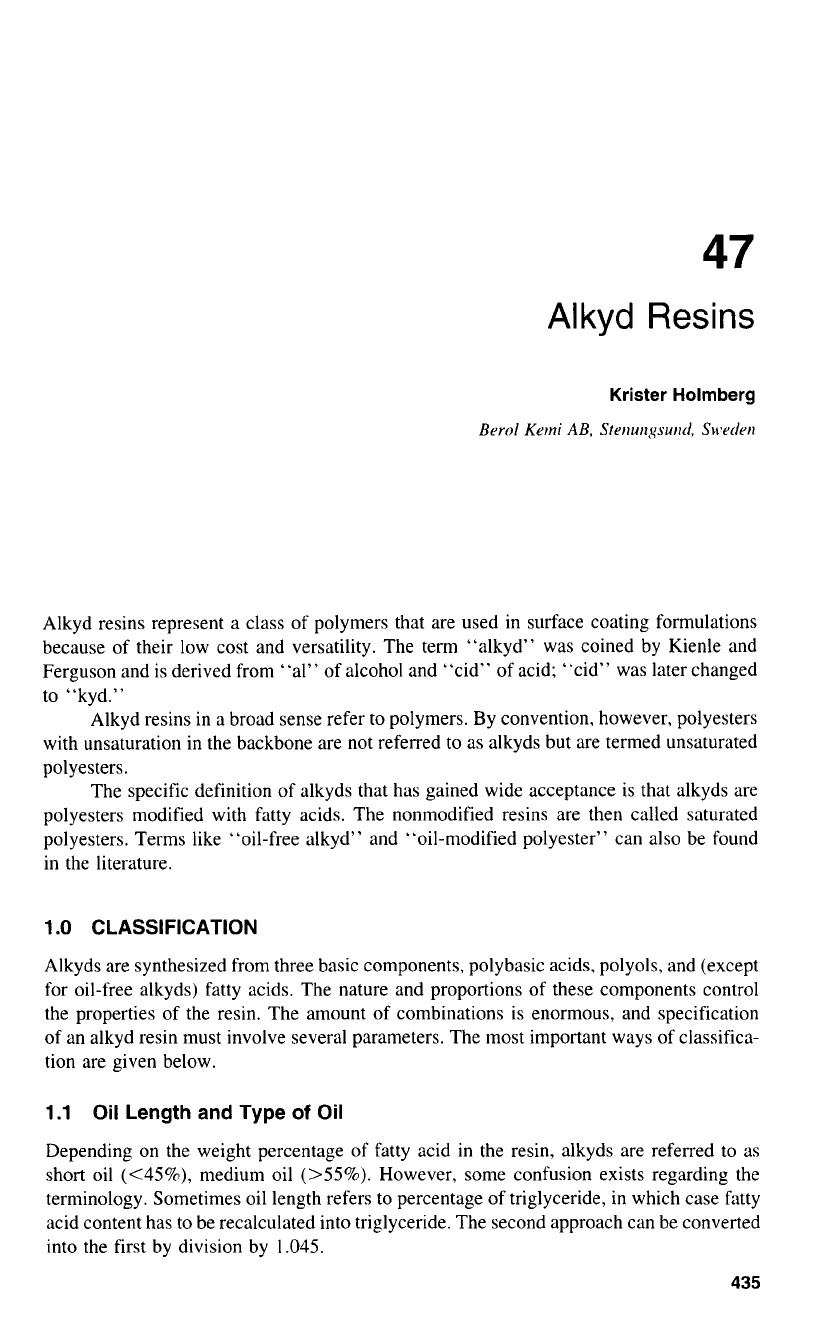
47
Alkyd
Resins
Krister Holmberg
Berol
Kmi
AB,
Sterumgsurld,
S,cwierl
Alkyd resins represent a class of polymers that are used in surface coating formulations
because of their low cost and versatility. The term “alkyd” was coined by Kienle and
Ferguson and is derived from “al” of alcohol and “cid”
of
acid; “cid” was later changed
to “kyd.”
Alkyd resins in a broad sense refer
to
polymers. By convention, however, polyesters
with unsaturation in the backbone are not referred
to
as alkyds but are termed unsaturated
polyesters.
The specific definition of alkyds that has gained wide acceptance
is
that alkyds are
polyesters modified with fatty acids. The nonmodified resins are then called saturated
polyesters. Terms like “oil-free alkyd” and “oil-modified polyester” can also be found
in the literature.
1
.O
CLASSIFICATION
Alkyds are synthesized from three basic components, polybasic acids, polyols, and (except
for oil-free alkyds) fatty acids. The nature and proportions
of
these components control
the properties of the resin. The amount of combinations is enormous, and specification
of an alkyd resin must involve several parameters. The most important ways of classifica-
tion are given below.
1.1
Oil
Length and Type
of
Oil
Depending on the weight percentage of fatty acid in the resin, alkyds are referred to as
short oil
(<45%),
medium oil
(>S%).
However, some confusion exists regarding the
terminology. Sometimes oil length refers to percentage of triglyceride, in which case fatty
acid content has
to
be recalculated into triglyceride. The second approach can be converted
into the first by division by
1.045.
435

436
HOLMBERG
The type of fatty acid used also governs the properties of the alkyds. The resins are
classified as drying, semidrying, and nondrying, depending on the degree of unsaturation
in the fatty acid residues (iodine number of
>140.
125-140,
and
<125,
respectively).
Oxidative drying of alkyds, which involves air oxidation of polyene structures in
fatty acid residues, is at maximum around
50%
oil length. After drying, film hardness is
inversely proportional to the degree of fatty acid modification.
Short oil alkyds generally give films
of
high quality with regard to color and gloss
retention but low flexibility and with poor adhesion. Long oil alkyds are usually superior
in terms
of
pigment dispersion, rheological properties, and storage stability.
Examples of properties
of
alkyd resins related to oil length and type of
oil
are shown
in
Table
1.’
Table
1
Effect
of
Oil Length and Type
of
Oil on the Properties and Uses of Alkyds
Oil type Oil length
(8)
Typical oil Properties
Oxidizing
2
60
Linseed, safflower, soybean,
tall oil fatty aclds; wood
oil in blends with other
oils; dehydrated castor
oil
Oxidizing
Oxidizing
45-55
545
Nonoxidizing
40-60
Nonoxidizing
540
Linseed, safflower, soybean.
tall oil fatty acids; wood
oil in blends with other
oils
Linseed, safflower, soybean,
tall fatty acids; wood oil in
blends with other oils;
dehydrated castor oil
Coconut oil, castor oil,
hydrogenated castor oil
Coconut oil, castor oil,
hydrogenated castor oil
Soluble in aliphatic solvents.
Compatible with oils and
medium oil length alkyds;
good drying
characteristics. Films are
flexible, with reasonable
gloss and durability
Soluble in aliphatic or
aliphatic-aromatlc solvent
mixtures. Good drying
characteristics, durability
and gloss
hydrocarbons. Low
tolerance for aliphatic
solvents. Usually cured at
elevated temperatures
either by heating with
manganese driers
or
with
urea or melamine
formaldehyde resins
Soluble in aliphatic-arornatlc
solvent blends. Usually
used
as
a plasticizer for
thermoplastic polymers
such
as
nitrocellulose
Soluble in aromatic solvents.
Soluble in aromatic
Used
as
a
reactive
plasticizer that chemically
combines with other resin
entlties (e.g. melamine-
forrnaldehydc resin)
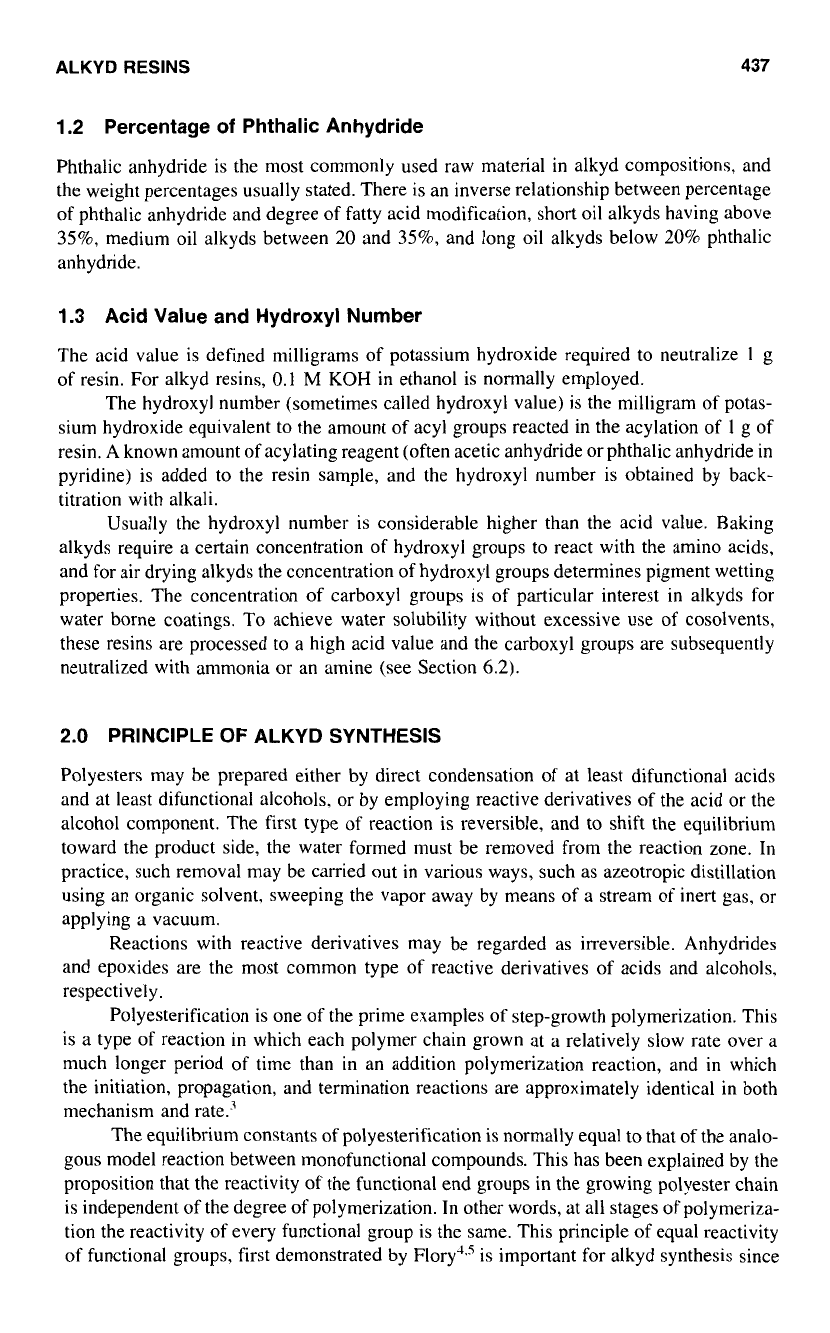
ALKYD
RESINS
437
1.2 Percentage of Phthalic Anhydride
Phthalic anhydride is the most commonly used raw material in alkyd compositions, and
the weight percentages usually stated. There is an inverse relationship between percentage
of phthalic anhydride and degree
of
fatty acid modification, short
oil
alkyds having above
35%,
medium oil alkyds between
20
and
35%,
and long oil alkyds below
20%
phthalic
anhydride.
1.3 Acid Value and Hydroxyl Number
The acid value is defined milligrams of potassium hydroxide required to neutralize
1
g
of resin. For alkyd resins,
0.1
M
KOH
in ethanol is normally employed.
The hydroxyl number (sometimes called hydroxyl value) is the milligram of potas-
sium hydroxide equivalent to the amount of acyl groups reacted in the acylation of
l
g of
resin. A known amount of acylating reagent (often acetic anhydride or phthalic anhydride in
pyridine) is added to the resin sample, and the hydroxyl number is obtained by back-
titration with alkali.
Usually the hydroxyl number is considerable higher than the acid value. Baking
alkyds require a certain concentration of hydroxyl groups to react with the amino acids,
and for air drying alkyds the concentration
of
hydroxyl groups determines pigment wetting
properties. The concentration of carboxyl groups is of particular interest in alkyds for
water borne coatings.
To
achieve water solubility without excessive use of cosolvents,
these resins are processed to a high acid value and the carboxyl groups are subsequently
neutralized with ammonia or an amine (see Section
6.2).
2.0 PRINCIPLE
OF
ALKYD SYNTHESIS
Polyesters may be prepared either by direct condensation
of
at least difunctional acids
and at least difunctional alcohols. or by employing reactive derivatives of the acid or the
alcohol component. The first type of reaction is reversible, and to shift the equilibrium
toward the product side, the water formed must be removed from the reaction zone. In
practice, such removal may be carried out
in
various ways, such
as
azeotropic distillation
using an organic solvent, sweeping the vapor away by means
of
a
stream of inert gas, or
applying a vacuum.
Reactions with reactive derivatives may be regarded as irreversible. Anhydrides
and epoxides are the most common type of reactive derivatives
of
acids and alcohols,
respectively.
Polyesterification is one of the prime examples of step-growth polymerization. This
is
a
type
of
reaction in which each polymer chain grown at a relatively slow rate over a
much longer period of time than
in
an addition polymerization reaction, and in which
the initiation, propagation, and termination reactions are approximately identical in both
mechanism and rate?
The equilibrium constants of polyesterification is normally equal to that of the analo-
gous model reaction between monofunctional compounds. This has been explained by the
proposition that the reactivity of the functional end groups in the growing polyester chain
is independent of the degree
of
polymerization. In other words, at all stages of polymeriza-
tion the reactivity of every functional group is the same. This principle of equal reactivity
of functional groups. first demonstrated by Flory'.' is important for alkyd synthesis since
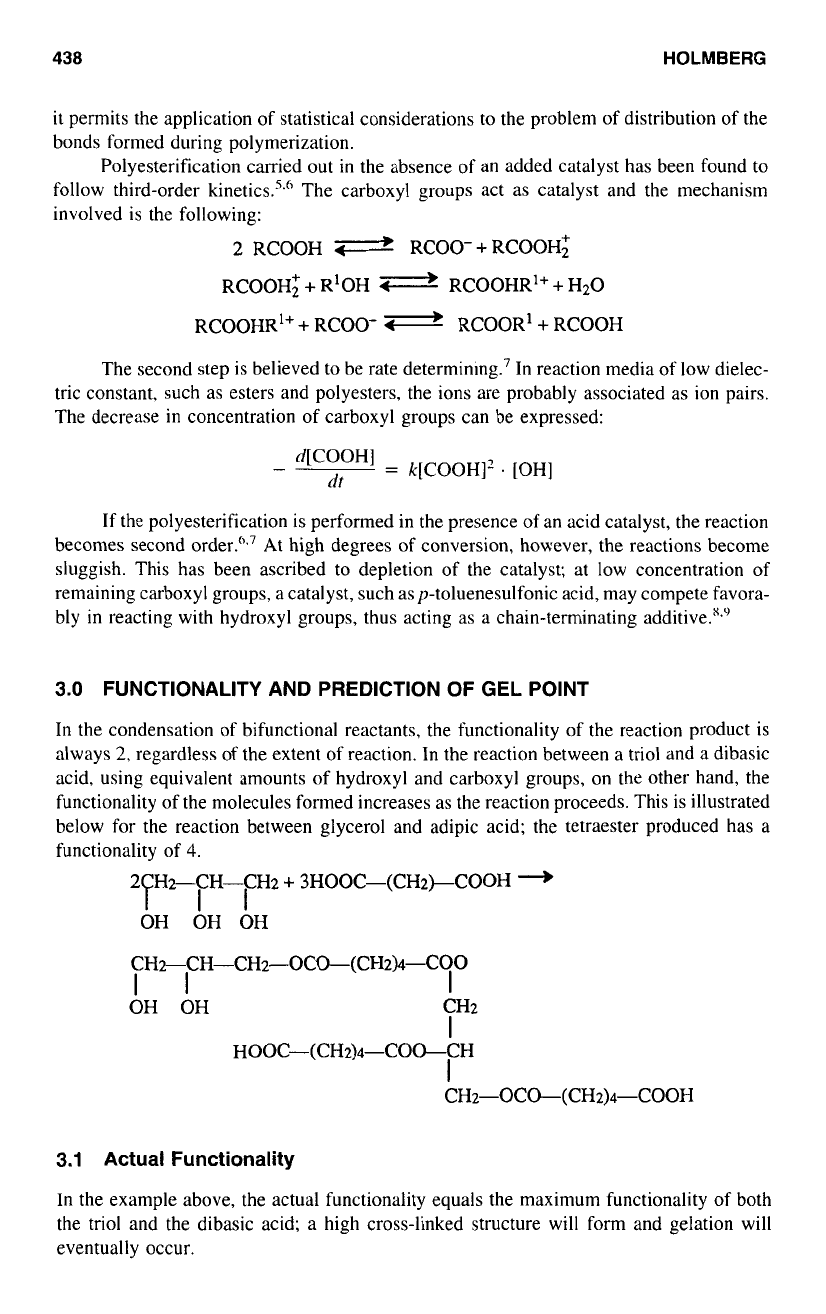
438
HOLMBERG
it permits the application of statistical considerations to the problem of distribution of the
bonds formed during polymerization.
Polyesterification carried out
in
the absence of an added catalyst has been found to
follow third-order kinetics."" The carboxyl groups act as catalyst and the mechanism
involved is the following:
2
RCOOH
P
RCOO-+
RCOOH~
RCOOH;
+
R'OH
P
RCOOHR'+
+
H20
RCOOHR~+
+
RCOO-
II
RCOOR'
+
RCOOH
The second step is believed to be rate determining.7 In reaction media
of
low dielec-
tric constant, such
as
esters and polyesters, the ions are probably associated as ion pairs.
The decrease
in
concentration of carboxyl groups can be expressed:
-
d'CooH1
=
k[COOH]'
.
[OH]
nr
If the polyesterification is performed in the presence of an acid catalyst, the reaction
becomes second order.".7 At high degrees of conversion, however, the reactions become
sluggish. This
has
been ascribed to depletion of the catalyst; at low concentration
of
remaining carboxyl groups,
a
catalyst, such asp-toluenesulfonic acid, may compete favora-
bly
in
reacting with hydroxyl groups, thus acting as a chain-terminating additive.x."
3.0
FUNCTIONALITY AND PREDICTION
OF
GEL POINT
In the condensation of bifunctional reactants, the functionality of the reaction product is
always
2,
regardless
of
the extent
of
reaction. In the reaction between a triol and a dibasic
acid, using equivalent amounts of hydroxyl and carboxyl groups, on the other hand, the
functionality of the molecules formed increases
as
the reaction proceeds. This is illustrated
below for the reaction between glycerol and adipic acid; the tetraester produced has a
functionality of
4.
2
H;?-CH"CH2
+
3HOOC-(CH2tCOOH
-
FII
OH OH OH
CHPCH-CH~-OCO-(CH~)COO
II
I
I
I
OH OH CH2
HOOC-(CH2)4-C00-CH
3.1
Actual Functionality
In the example above, the actual functionality equals the maximum functionality
of
both
the triol and the dibasic acid; a high cross-linked structure will form and gelation will
eventually occur.
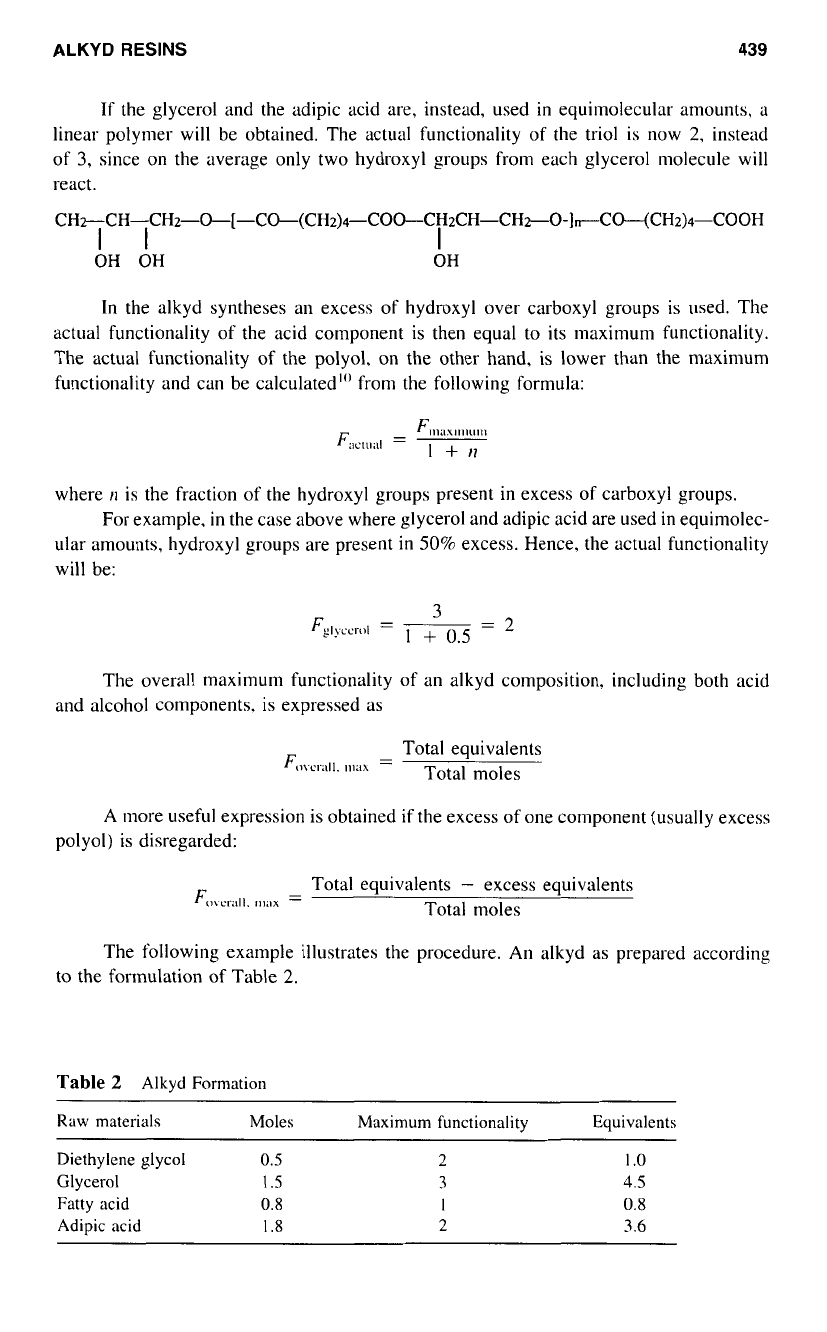
ALKYD
RESINS
439
If the glycerol and the adipic acid are, instead, used
in
equimolecular amounts, a
linear polymer will be obtained. The actual functionality of the triol is now
2,
instead
of
3,
since
on
the average only two hydroxyl groups from each glycerol molecule will
react.
CH~"CH-CHZ-O-[-CO-(CH~)~-CO~CHZCH-CH~O-]"CO"(CHZ)~-COOH
II I
OH
OH
OH
In
the alkyd syntheses an excess of hydroxyl over carboxyl groups is used. The
actual functionality of the acid component is then equal
to
its maximum functionality.
The actual functionality of the polyol, on the other hand, is lower than the maximum
functionality and can be calculated"' from the following formula:
where
IZ
is the fraction
of
the hydroxyl groups present
in
excess of carboxyl groups.
For example, in the case above where glycerol and adipic acid are used
in
equimolec-
ular amounts, hydroxyl groups are present
in
50%
excess. Hence, the actual functionality
will be:
The overall maximum functionality
of
an alkyd composition, including both acid
and alcohol components. is expressed as
-
Total equivalents
F,,,,,.;,,,.
IllilX
-
Total moles
A
more useful expression is obtained
if
the excess of one component (usually excess
polyol) is disregarded:
-
Total equivalents
-
excess equivalents
F<ncl.illl.
Ill:Ix
-
Total moles
The following example illustrates the procedure.
An
alkyd as prepared according
to the formulation of Table
2.
Table
2
Alkyd Formation
Raw
materials Moles Maximum functionality Equivalents
Diethylene glycol
0.5
Glycerol
I
.S
Fatty acid
0.8
Adipic acid
1
.S
1
.o
4.5
0.8
3.6
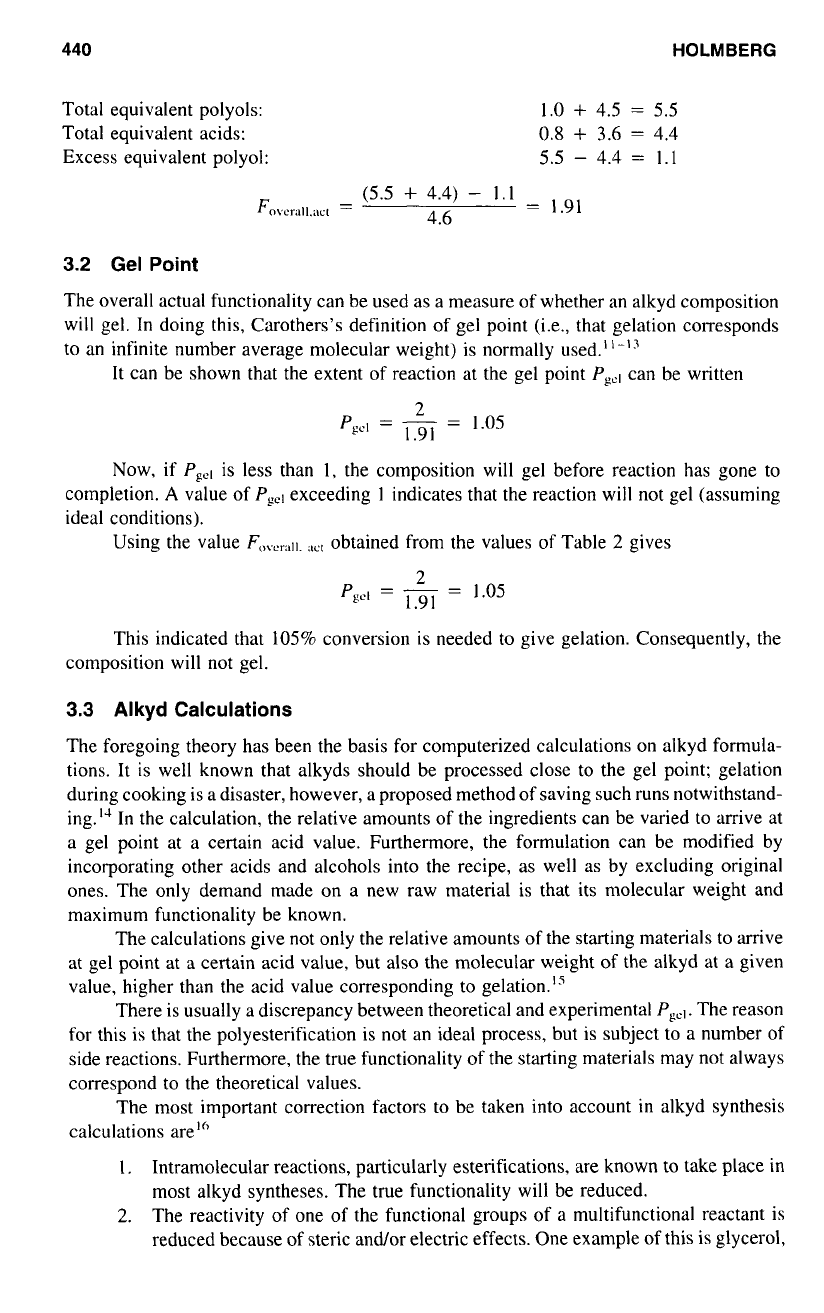
440 HOLMBERG
Total equivalent polyols:
Total equivalent acids:
Excess equivalent polyol:
1.0
+
4.5
=
5.5
0.8
+
3.6
=
4.4
5.5
-
4.4
=
1.1
(5.5
+
4.4)
-
1.1
4.6
Fo\crnll.nc,
=
=
1.91
3.2
Gel
Point
The overall actual functionality can be used
as
a measure of whether an alkyd composition
will gel. In doing this, Carothers's definition
of
gel point (i.e., that gelation corresponds
to an infinite number average molecular weight) is normally used.""'
It
can be shown that the extent of reaction at the gel point
P,,,
can be written
P,,,
=
-
1.91
-
1.05
Now, if
P,,'
is less than
I,
the composition will gel before reaction has gone to
completion.
A
value of
P,,I
exceeding
1
indicates that the reaction will not gel (assuming
ideal conditions).
Using the value
F~,v,~lll.
ilcf
obtained from the values of Table
2
gives
P,,,
=
-
-
L
1.91
-
1.05
This indicated that 105% conversion is needed
to
give gelation. Consequently, the
composition will not gel.
3.3
Alkyd
Calculations
The foregoing theory has been the basis for computerized calculations on alkyd formula-
tions. It is well known that alkyds should be processed close to the gel point; gelation
during cooking is a disaster, however, a proposed method
of
saving such runs notwithstand-
ing." In the calculation, the relative amounts of the ingredients can be varied
to
arrive at
a gel point at a certain acid value. Furthermore, the formulation can be modified by
incorporating other acids and alcohols into the recipe, as well as by excluding original
ones. The only demand made
on
a new raw material is that its molecular weight and
maximum functionality be known.
The calculations give not only the relative amounts
of
the starting materials to arrive
at gel point at a certain acid value, but also the molecular weight
of
the alkyd at a given
value, higher than the acid value corresponding to gelation.IS
There is usually
a
discrepancy between theoretical and experimental
P,,'.
The reason
for this is that the polyesterification is not an ideal process, but is subject to a number of
side reactions. Furthermore, the true functionality of the starting materials may not always
correspond to the theoretical values.
The most important correction factors to be taken into account
in
alkyd synthesis
calculations are'"
1.
Intramolecular reactions, particularly esterifications, are known to take place in
most alkyd syntheses. The true functionality will be reduced.
2.
The reactivity of one
of
the functional groups of a multifunctional reactant is
reduced because of steric and/or electric effects. One example
of
this is glycerol,
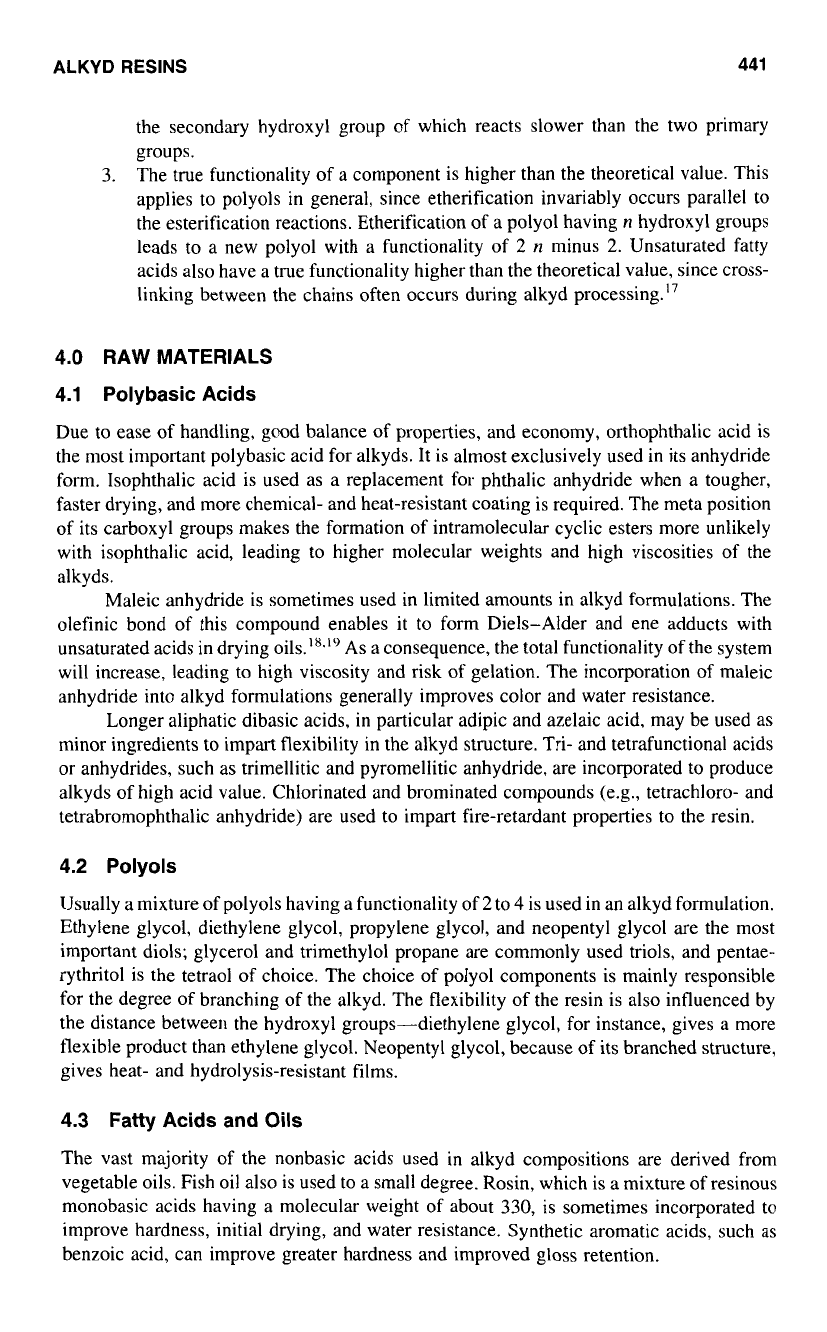
ALKYD
RESINS
441
the secondary hydroxyl group
of
which reacts slower than the two primary
groups.
3.
The true functionality of a component is higher than the theoretical value. This
applies to polyols in general, since etherification invariably occurs parallel to
the esterification reactions. Etherification of a poly01 having
n
hydroxyl groups
leads to a new poly01 with a functionality of
2
n
minus
2.
Unsaturated fatty
acids also have a true functionality higher than the theoretical value, since cross-
linking between the chains often occurs during alkyd processing."
4.0 RAW MATERIALS
4.1
Polybasic Acids
Due to ease of handling, good balance
of
properties, and economy, orthophthalic acid is
the most important polybasic acid for alkyds. It is almost exclusively used in its anhydride
form. Isophthalic acid is used as a replacement for phthalic anhydride when a tougher,
faster drying, and more chemical- and heat-resistant coating is required. The meta position
of
its carboxyl groups makes the formation of intramolecular cyclic esters more unlikely
with isophthalic acid, leading to higher molecular weights and high viscosities of the
alkyds.
Maleic anhydride is sometimes used in limited amounts in alkyd formulations. The
olefinic bond of this compound enables
it
to
form Diels-Alder and ene adducts with
unsaturated acids in drying oils.'8.'"
As
a consequence, the total functionality of the system
will increase, leading
to
high viscosity and risk
of
gelation. The incorporation of maleic
anhydride into alkyd formulations generally improves color and water resistance.
Longer aliphatic dibasic acids, in particular adipic and azelaic acid, may be used as
minor ingredients to impart flexibility in the alkyd structure. Tri- and tetrafunctional acids
or anhydrides, such as trimellitic and pyromellitic anhydride, are incorporated to produce
alkyds of high acid value. Chlorinated and brominated compounds (e.g., tetrachloro- and
tetrabromophthalic anhydride) are used to impart fire-retardant properties to the resin.
4.2
Polyols
Usually a mixture of polyols having a functionality of
2
to
4
is used in an alkyd formulation.
Ethylene glycol, diethylene glycol, propylene glycol, and neopentyl glycol
are
the most
important diols; glycerol and trimethylol propane are commonly used triols, and pentae-
rythritol is the tetraol of choice. The choice of poly01 components is mainly responsible
for the degree of branching of the alkyd. The flexibility of the resin is also influenced by
the distance between the hydroxyl groups-diethylene glycol, for instance, gives a more
flexible product than ethylene glycol. Neopentyl glycol, because
of
its branched structure,
gives heat- and hydrolysis-resistant films.
4.3
Fatty Acids and Oils
The vast majority
of
the nonbasic acids used
in
alkyd compositions are derived from
vegetable oils. Fish oil also is used to a small degree. Rosin, which is a mixture of resinous
monobasic acids having a molecular weight of about
330,
is sometimes incorporated to
improve hardness, initial drying, and water resistance. Synthetic aromatic acids, such as
benzoic acid, can improve greater hardness and improved gloss retention.
